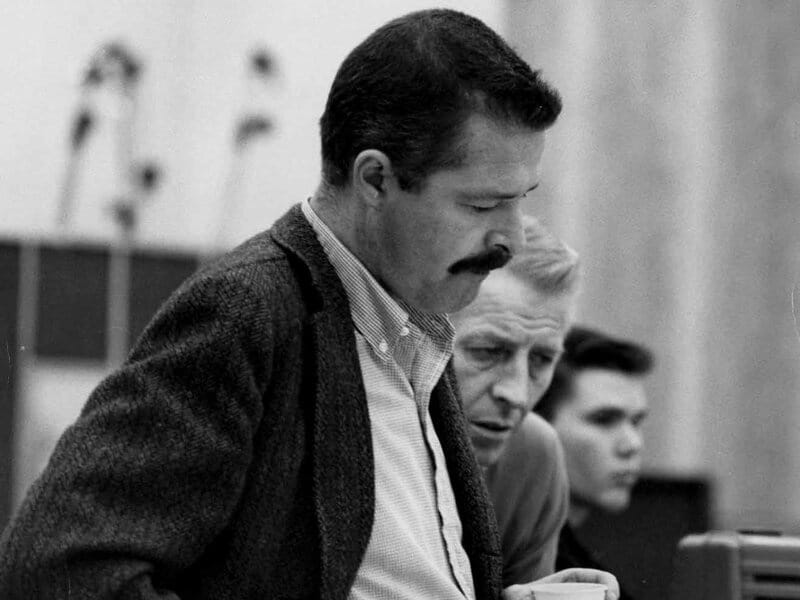The great arranger Bill Holman passed away at the age of 96 last Monday. A three-time Grammy Award winner nominated on sixteen occasions, he was at the forefront of West Coast Jazz in the fifties and helped to shape the sounds of famous big bands from Stan Kenton and Buddy Rich to Woody Herman and Terry Gibbs.
When looking back at the remarkable career of arranger, composer, and saxophonist Willis Leonard “Bill” Holman, it is important to consider how he has so profoundly influenced generation after generation of big band players and writers. Of course, many came to know of him for his work with the likes of Stan Kenton, Buddy Rich, Woody Herman, Peggy Lee, Maynard Ferguson, Natalie Cole, and hundreds of others, or perhaps from his humble but top-notch discography as a leader. Yet, at this point, an equal number of younger players are more likely to have first heard the name Bill Holman playing his widely circulated arrangements in school and college bands. Indeed, he has made countless contributions, knowingly or unknowingly, to the pads of bands from legendary to professional to amateur, making it impossible to overstate the influence he has had on large ensemble jazz over the past seven decades.
Holman was already an experienced player by the time he joined Stan Kenton’s band on tenor sax in 1952, and the arrangements he went on to contribute to the band over the following several years are intrinsically linked with the sound of the band from that point on. He and fellow arranger Bill Russo were the perfect geniuses to progress Kenton’s ambition of moving past the commercial music of the forties. Not only did they reshape the band’s repertoire, they helped to re-establish the jazz orchestra’s place as part of a more serious art form, in many ways building on what Duke Ellington started two decades prior. Holman especially continued to shape the Kenton band long after he left as a player, contributing chart after chart until well into the seventies.

His contributions to small group jazz in California around the mid to late-fifties were equally impactful. The West Coast Sound, recorded in 1953 and 1955 and released in 1956 under drummer Shelly Manne’s name, thoroughly encapsulates the sound he and others were pioneering during the era. He and Russo – along with Shorty Rogers, Jimmy Giuffre, Marty Paich, and Bob Enevoldson – arranged music selected by Manne for a lineup of alto, tenor, and baritone saxes, valve trombone, and rhythm section. Flavours of Gerry Mulligan and Birth of the Cool, as well as contemporary classical composers like Stravinsky to Charles Ives, are present and strong in the writing here.
They all continued working on projects of their own with similar small group lineups in the latter years of the fifties. Most of them, Holman especially, also went on to shape the sound of Terry Gibbs and his Dream Band in the early sixties. To me, the sound of that great band is, in large part, the sound of Bill Holman because of the massive contributions he made to their repertoire.
Shortly after, the jazz scene in California largely dried up, forcing Holman and many of his contemporaries into commercial studio work. He did an extraordinary amount of work over the next three decades, too many projects to mention here, but surprisingly made no recordings as a leader between the years of 1960 to 1987. For the remainder of this tribute, I want to take a more in-depth look at two arrangements that appear on some of his later recordings. I must credit Richard Iles for introducing me to them while I was his student at Chetham’s School of Music. Both have gone on to have a significant influence on me as an arranger…
- Just Friends
I have seen a good deal of discussion about Bill Holman’s arrangement of “Just Friends” on X (Twitter) over the past week. It seems to have had as major an influence on many other arrangers, and with good reason: Firstly, this tune is a well-known one, thus Holman can creatively deconstruct and reimagine it while maintaining its original character. The writing is somehow familiar – faithful enough to the melody of “Just Friends” – yet is also totally original. He presents this rephrased melody in complete unison from the beginning, putting his immense harmonic facility to one side for several choruses and turning over a dozen individual horns into one unified, ultra-lyrical voice. The overall effect is a build-up of tension that explodes with a roaring shout chorus, one that is quintessentially Holman, towards the end.
He humbly described it as simply being his ‘re-enactment of a jam session, as arranged for band.’ But to the rest of us, it is more profound. Perhaps no one said it better than Maria Schneider, commenting in a past interview:
“Bill Holman has a sound, a beautiful and personal sound. I’ll never forget the impact his wonderful arrangement of ‘Just Friends’ had on me. It’s so daring, so simple, and so uniquely and perfectly him. It has just the bare ingredients, but through it comes his sound. It’s impossible for him not to be him. That’s the definition of a true artist.”
Though it first appeared on The Bill Holman Band (1987), I instead chose to spotlight (above) a version by the WDR Band from 2000. It features Holman himself directing with special guests James Moody, who plays a terrific tenor solo, and Jeff Hamilton on drums. It is a fine performance, but it interestingly highlights that, while the concept of this chart may sound simplistic, the exposed nature of the melody at times even challenges players as experienced as these.
- Straight, No Chaser

The only recording of this arrangement I am aware of is from Holman’s 1997 recording Brilliant Corners: The Music of Thelonious Monk, which, as the title eludes to, features Monk compositions as reimagined by the arranger. “Straight, No Chaser” especially showcases his slick mastery of dissonance and counterpoint. As is the case here, he often applies those elements to arrangements in combination with endlessly creative, swinging lines; it is above all what makes his writing so distinct. But I think what makes it that bit more impactful here, similar to “Just Friends”, is how he paces the arrangement. Maybe it’s just the unison sopranos at the top of the chart, but it all reminds me of Bob Brookmeyer and how he tends to pace his arrangements, maximising big moments by delaying them.
Unfortunately, I cannot find a link to the recording. But I thoroughly recommend it to anyone who can get their hands on the album (it’s the opening track). In my opinion, Holman captures the spirit of Monk on it better than anyone else who has attempted to arrange his music for large ensemble.
I first read of Bill Holman in Arranging for Large Jazz Ensemble, a textbook from Berklee Press outlining the basics of arranging. It culminates in some different example scores of the “Happy Birthday” song, arrangements based on the styles of four different arrangers: Duke Ellington, Count Basie, Gil Evans… and Bill Holman! High praise indeed, though he certainly earned the honour of being remembered alongside such names. The longevity and influence of his career was a marvel to behold – virtually unparalleled. Jazz has truly lost one of its greats.


